Level 8 floor routines start to get a bit more difficult, compared with Levels 6 and 7. Level 8 is the third optional level in gymnastics. Optional gymnastics means that the gymnast gets to use their own choreography. Level 8 floor music can be chosen by the gymnast and coach. Today we will look at the Level 8 floor routine requirements, and what type of skills can be used to meet them.
Level 8 is the first level in which composition deductions can be taken. These deductions are based on the construction of the routine. Deductions reflect the difficulty, quantity, and type of skills and choreography in the routine. Coaches and gymnasts must design routines based on not only the Special Requirements, but the composition requirements as well.
This post has been updated to reflect the 2022-2026 Code of Points.
Basic Requirements for a Level 8 Floor Routine
Once a gymnast gets to Optional levels (Levels 6-10), they must perform a certain number of skills (Value Parts). Each level has different requirements for the number of skills at varying degrees of difficulty. Missing Value Parts are reflected in the Start Value.
Next, the gymnast must fulfill four Special Requirements on each event. Missing Special Requirements are also reflected in the Start Value.
Finally, the gymnast will have Composition Requirements for each event. Composition deductions are taken at the end of the routine, and are NOT reflected in the Start Value. These deductions are not covered in this article. Read Making Sense of Composition: Level 8 Floor to learn more.
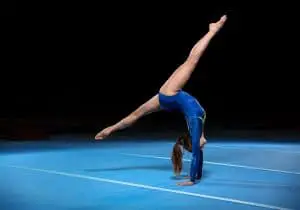
Value Parts for a Level 8 Floor Routine
Level 8 gymnasts need 4 A skills and 4 B skills on each event (bars, beam, and floor). All skills in gymnastics are evaluated based on their difficulty level, and they are given a value from A through E. A skills are the easiest, while B skills are a bit more difficult. The gymnast is allowed to choose the skills that she can perform the best in each of these difficulty categories. Each A skill is worth 0.10, and each B skill is worth 0.30. Deductions are taken off the Start Value if a skill is missing.
In a Level 8 floor routine, gymnasts are allowed to perform A and B skills, along with unlimited C dance elements. They are also allowed ONE acro C without penalty. Performance of additional acro C’s or any D/E skills will result in a 0.50 deduction from the Start Value for a restricted element.
Examples of B skills on floor include:
- Switch leap
- Side leap
- Straddle jump
- Pike jump
- Tuck jump 1/1 turn
- Straight jump 1 1/2 turn
- 1 1/2 turn
- Full turn with leg held at horizontal
- Front pike
- Front layout
- Back layout 1/2
- Back layout full
Special Requirements for a Level 8 Floor Routine
There are four Special Requirements for a Level 8 floor routine. Each Special Requirement is worth 0.50. If a Special Requirement is missing, it is a deduction of 0.50 off the Start Value.
The Level 8 requirements for floor are as follows:
- Acro pass with minimum of 2 saltos
- Three different saltos (NOT aerials)
- Dance passage (2 leaps, jumps, or hops), including one 180° leap
- Min. A salto in last salto connection
Here is more detail on each of these Special Requirements.
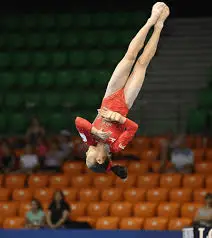
Acro Pass With Minimum of 2 Saltos
An acro pass is a tumbling pass consisting of at least one acro element. The 2-salto acro pass in a Level 8 floor routine must contain at least two saltos, directly or indirectly connected. The two saltos can be the same or different.
A direct acro connection means that the two saltos are connected with no other skills in between.
Aerials are NOT considered saltos.
Examples of direct acro connections that fulfill this requirement:
- Front tuck, front tuck
- Front layout, front pike
- Roundoff, whip, back tuck
- Roundoff, whip 1/2, front layout
- There are lots of possibilities! Leave a comment with some of your favorite Level 8 acro series.
An indirect acro connection is a salto connection with additional flight elements between the saltos.
Examples of indirect acro connections that fulfill this requirement:
- Roundoff, whip, back handspring, back layout full
- Front tuck stepout, roundoff, back tuck
- Front handspring, front tuck stepout, front handspring, front pike
- Roundoff, Arabian salto stepout, roundoff, back layout
- Again, there are many possible combinations!
The great part about Level 8 is that there are SO many ways to meet the requirements, and coaches and gymnasts can choose the skills that best suit that gymnast’s individual strengths.
Not the greatest twister? No problem! Get some B saltos with a front pike or layout.
Can’t tumble out of a back handspring? Just do a roundoff into your back tumbling pass!
Three Different Saltos in the Routine
The gymnast must perform three different saltos during the routine. These saltos can be isolated or in combination.
The same salto in a different connection will NOT count as a different salto for this requirement.
Saltos with a step-out and to two feet are considered the SAME.
Aerials will NOT meet this requirement. They are not considered saltos.
All saltos must land on the bottom of the feet first to get Value Part and Special Requirement credit. For example, a front tuck that lands on the back or the seat first will not get credit.
Examples of Floor Routines That Meet the Acro Requirements
See examples in Making Sense of Composition: Level 8 Floor.
Note that both a 2-pass and a 3-pass routine are acceptable. Coaches and gymnasts can choose what works best for them!
When deciding between a 2-pass and 3-pass routine, consider the difficulty of the skills the gymnast can perform. 2-pass routines have more difficult composition requirements, which means that some gymnasts will get more composition deductions with these routines.
On the flip side, an extra acro pass is an extra opportunity for judges to take deductions. Look critically at the passes you’re considering, to determine what execution deductions might occur. Then look at the composition chart, and you can decide if it makes more sense to do 2 or 3 passes.
Dance Passage
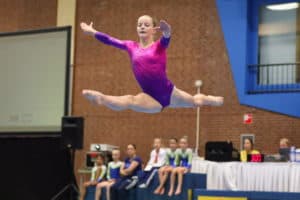
The dance passage must consist of at least 2 skills from Group 1 (leaps, jumps, or hops). At least one of the skills in the dance passage must be a leap, which takes off from 1 foot, that achieves a 180° split.
There is an almost endless variety of combinations that a Level 8 gymnast can do to fulfill this requirement.
Some examples of 180° leaps are:
- Split leap
- Side leap
- Switch leap
- Tour jete
- Switch-side
- Switch-ring
- Switch-1/2
The dance passage is also a common place for gymnasts to perform one or more of their required “B” elements. Some examples of dance “B” elements are:
- Switch leap
- Side leap
- Straddle jump
- Pike jump
- Jump 1 1/2 turn
- Tuck jump 1/1 turn
- Split jump 1/2 turn
- Shushunova
- Tour jete
- Ring leap
- Cat leap 1/1 turn
If the gymnast performs a “C” dance element, it receives “B” credit. Unlimited dance “C” elements are allowed in a Level 8 floor routine. This is a great place to learn dance skills that can receive bonus in Level 9, although it may not be beneficial to perform these difficult combinations unless they can be performed very cleanly!
Minimum “A” salto in last salto connection
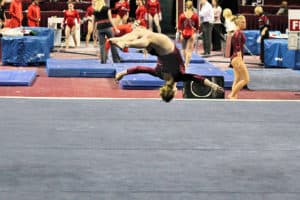
Since Level 8 gymnasts need to perform at least 3 saltos in their routine, most gymnasts will get credit for this requirement automatically. There are only a few scenarios in which they might not receive credit.
1. Gymnast performs the exact same pass twice in her routine.
EXAMPLE: First pass is a front handspring, front tuck. Then, gymnast tries to do a front handspring, front pike as her final pass, but she bends her knees and receives credit for another front tuck. This second front tuck would not receive Value Part credit, and the gymnast would lose the Special Requirement for the “A” salto in the last salto connection.
2. Gymnast performs a salto for the third time in the routine. That one is pretty self explanatory.
3. Restricted skill is performed as the last salto in the routine.
EXAMPLE: First pass is a double full (C value). Final pass is a front layout-full (also C value). Level 8 gymnasts may only perform 1 C acro skill in their routine, so the final pass gets 0 VP credit, and therefore no Special Requirement credit either.
4. Last salto does not land on the bottom of the feet first. It would get 0 VP credit, and therefore no Special Requirement credit.
5. Gymnast does not initiate a salto in the final acro pass.
EXAMPLE: Gymnast runs, and does not perform an acro pass.
EXAMPLE: Gymnast does roundoff back handspring, and bails out without performing a salto.
In these last two examples, a 0.30 deduction for No Dismount would also apply.
Common Deductions for a Level 8 Floor Routine
In Level 8 gymnastics, gymnasts are expected to perform more difficult skills, but that doesn’t mean they can sacrifice technique. Many times, I have seen a less difficult routine, cleanly executed, beat out a difficult routine with more errors. What do I mean by “cleanly executed”? A gymnast with clean execution has minimal form deductions.
Here are some of the most common deductions that can occur during a Level 8 floor routine. These deductions are assessed each time they occur.
Common deductions include:
- Foot form – 0.05
- Concentration pause – 0.10 (2 seconds or more)
- Legs not parallel to floor in split or straddle-pike leaps/jumps – up to 0.20
- Insufficient split when required – up to 0.20
- Insufficient height (dance skills, aerials, or acro flight skills) – up to 0.20
- Insufficient height (saltos) — up to 0.30
- Incomplete turn/twist – up to 0.20
- Poor body position – up to 0.20
- Incorrect posture on landings of elements and dismount — up to 0.20
- Leg separation – up to 0.20
- Bent arms – up to 0.30
- Bent knees – up to 0.30
- Insufficient open of tuck/pike position prior to landing acro elements — up to 0.30
- Deep squat on landing — up to 0.30
- Fall – 0.50
- Coach on the floor — 0.50
General Deductions in a Level 8 Floor Routine
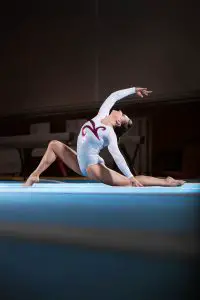
In a Level 8 floor routine, there are several categories of “general deductions”, which are evaluated by looking at the routine as a whole. These deductions are:
- Rhythm – up to 0.30
- Dynamics – up to 0.20
- Footwork – up to 0.30
- Posture/alignment – up to 0.30
- Artistry – up to 0.30 (3 categories of artistry)
For more information on general deductions, see 6 General Deductions You’re Probably Getting.
Final Thoughts
The best Level 8 floor routines are clean, dynamic, and artistic! As discussed above, it’s best to choose skills that showcase the gymnast’s abilities. For instance, if the gymnast has poor flexibility, she might opt to perform only the minimum elements that require a full split, and use other skills to fulfill the rest of the requirements. If her feet aren’t as flexible, the routine might use choreography that doesn’t rely on fully pointed feet. You get the idea!
The top Level 8 floor routines will also show great rhythm, posture, and footwork. The gymnast should should have quick, high tumbling, and clean dance skills with good form and flexibility. It’s fun to see gymnasts really getting into it when selling their routines! There’s a lot of room to be creative in a Level 8 floor routine, so find an original piece of choreography and keep working to show it off!
Further Reading
The Ideal Composition for a Level 8 Bar Routine
Making Sense of Composition: Level 8 Beam
How to Demonstrate Artistry in Gymnastics
Level 6 Floor Routine Requirements
Level 7 Floor Routine Requirements
Making Sense of Composition: Level 8 Floor
Making Sense of Composition: Level 9 Floor
Making Sense of Composition: Level 10 Floor
References
USA Gymnastics J.O. Code of Points, 2022-2026.